So, what happened to the wood that sparked a party?
Time in the shop is sparse in the summertime. Yet, I have found time to make a pair of grooving planes. These are destined for making grooves that hold the bottom panels of boxes. Those grooves are always the same width and the same distance from the edge of their boards. Making two planes, provides one for each grain direction.
The idea and plans came from Fine Woodworking’s Matt Kenny. FW has the article online here. Lie-Nielsen also offers an article with plans (PDF) at no charge. That’s because Lie-Nielsen makes and sells irons for these planes. Whoa there, back up and hit that link. The only negative thing I’ve ever had to say about Lie-Nielsen is their web site has no search function. Shopping for something specific in their online catalog is like Where’s Waldo. The irons arrive fully sharpened and ready to use. But, I polished them some more.
The plane is made as a 3 layer sandwich, Krenov style. The outer layers of my planes are beech from Woodworkers Source, the people who threw a party when they packed and shipped my $32 order. I ordered sample blocks (3″ x 6″ x 1/2″) because they were very close to the sizes needed. They took only a little resawing and sizing to match the plans. I used some Cherry I already had for the 1/8″ thick inner layer and wedges. That inner layer serves as the skate and projects to the desired groove depth of 1/8″.
UPDATE – Jan 8, 2021: As Sergey noted in the comments below, Lie-Nielsen no longer sells these 1/8″ wide irons. There must not be enough demand for them. The only alternative I see is to use one of their 1/2″ irons, grind it down (ugh, what a lot of work) and re-temper it.
Matt Kenny’s Fine Woodworking article has also moved. It is in the May/June 2011 hardcopy version of the magazine. The digital version is behind a paywall for Fine Woodworking subscribers at “Make a Pair of Grooving Planes.” A downloadable version of that article, again for Fine Woodworking subscribers, is at this PDF link.
I didn’t take step-by-step photos, but you can get those from the article. Unlike Kenny’s, all of my construction was with hand tools and not at all difficult. If you make a pair, don’t fret too much with extreme accuracy. Make the rebate for the fence very accurate and the rest works itself out. After assembly, you’ll be paring or sanding the skate for smooth, but not sloppy, travel in the groove. My planes are marked “A” and “B” only to pair the respective wedges with their intended plane. Made by hand, the throats vary enough that the wedges aren’t interchangeable. Such a little nit.
What a joy to use. Pick ’em up. register and push. Smooth! And these irons cut much cleaner than those in my vintage Record 044.
Lastly, there’s also a lot of joy in dealing with a company like Woodworkers Source. Yes, the humorous shipping notice is a clever marketing ploy from a firm that has a great sense of humor. It doesn’t end there either. A follow up email from the company owner, “Craig Haggarton and The 107 Good Looking Lumber Pickers,” asks if everything arrived, was OK, post a review, etc. Yes, I’m a geek who does a lot of web development work and I know these things are a SMOP, but not every firm behaves this way. Good for them!
SMOP – Simple Matter Of Programming
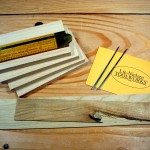
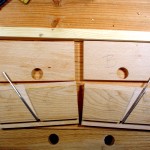
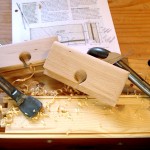
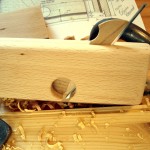
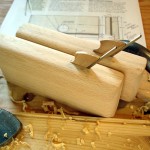
Thanks for the link for the article on how to make these little planes! I’ve been wanting to make a couple for sometime! I also thank you for making your planes with hand tools, it seems that many woodworkers can’t understand that you can make something with hand tools! Keep up the good work!
Hi Wilson,
THANKS for stopping by and leaving a comment. Classical guitar music is one of my favorite genres. Leaving a link to your lutherie just opened up yet another web of enjoyment.
Thanks for the description, Bob. I’ve tried making a groove plane, but it is somewhat crude and this is such an improvement!
Hi Fil,
The next one is always better. -)
BTW, I’m an oilstone man; no patience for all the water rituals.
Another BTW, that chunk of wood on your bench back in June looks like sycamore to me. That’s if what I’m seeing is remnants of the bark pattern. Lots of sycamores around here and their bark is fairly smooth and very distinctive.
I just Google’s ‘sycamore’ and the bark looks exactly like what I have – thanks for that! The internet also tells me sycamore is unstable as a material, but hopefully I’ll find a use for it…
Well… It appears that Peter Lloyd didn´t read that article about sycamore being unstable. He´s done some very nice boxes in sycamore. See: http://www.finehardwoodboxes.com/box-gallery/jewellery-boxes
Bob, just an FYI; lie-nielsen, and every other crawled site, has a built-in search function. By way of example, here’s the search query for those grooving planes entered into a google, bing, duckduckgo, and I’m sure a few others:
site:lie-nielsen.com Grooving Plane Blades
I was just looking for some of the high-friction tape on lee valley. Away we go:
site:leevalley.com high-friction tape
And, your blog regarding wedged tenons:
site:bob-easton.com wedged tenons
Best of luck,
Your friend Tuck
Yep, you’re almost right Tuck … That’s not really a “built-in” search. It’s an off-site search, done at Google, Yahoo, or whatever and one has to remember how to do it. My complaint was they didn’t have an on-site search with a search field as an integral part of the site, something every retailer should think of as “must have.”
Keep havin’ fun!
Lie-Nielsen doesn’t sell those blades anymore. Neither PDF of plane is available.
Bob, I’m not sure if you still read comments on a nine year old blog post, but I love running across your work as I am looking for resources to inform my own work.
Specifically, I am building a Harry Bryan Fiddlehead (CHECK) and I want to resaw the planking stock with a Roubo frame saw (CHECK) and instead of trying to build a specialized grooving saw to guide the cut, I was thinking about building a grooving plane with a 1/8” chisel to guide the frame saw kerf. Which landed me here.
Thanks for the good work you do and all of the effort you put into documenting it. I know that it is a lot of work, but I would like to let you know that the documents you’ve made and given to the world of hand tool woodworking are valuable resources for people like me who are following in (apparently all of) your footsteps.
Hi Neil,
It pleases me to know that those old posts are still useful to people. Thanks for mentioning it. I know you are going to have a great time with The Fiddlehead. It’s a fine boat.
Keep havin’ fun.